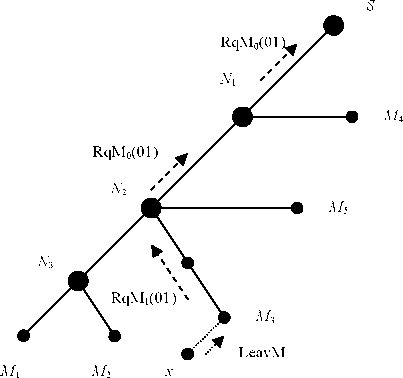■ Case 2:
In this case, where receiver (x) is the last group member attached to the designated LMR, and
the first BNR connecting the designated LMR will stay a BNR after member (x) leaving the
multicast group. Figure 4.10 shows this case, where the receiver (x) will send a leavM
message to the designated LMR (M3), upon receiving this message, M3 will create and
forward RqM1(01) message toward the source. The first BNR (N2) upon receiving this
message from (M3) it will check its MFT deciding whether it will stay a BNR or not. In this
case N2 will stay as a BNR, and will update the message by changing the S bit to zero and
forward the updated RqM0(01) message the source. At the same time N2 will update its MFT
by removing the entry for the M3. The RqM0(01) sent by N2 will go directly to the source
and no process will take place on this message in the intermediate IMRs or BNRs. Again, in
this case the multicast tree structure will not be changed.

Figure 4.10 Leaving process in SReM (Case 2)
|
Nodes |
MFTs | |
|
Before x leaves |
After x leaves | |
|
S (Source) |
MTI | IP_N1 |
unchanged |
|
N1 |
MTI | IP_N2 &IP_M4 |
unchanged |
|
N2 |
MTI | IP_N3 , IP_ M3 , IP_M5 |
MTI | IP_N3 & IP_M5 |
|
N3 |
MTI | IP_M1 & IP_M2 |
unchanged |
Leave message
RqM
■ Case 3:
In this case, shown in Figure 4.11, the BNR(N2) will not stay a BNR after receiver x leaves
the multicast group session. The existing LMR (M3) will send RqM1(01) message to the first
BNR(N2). Upon receiving this message N2 will check its MFT table, it realizes that M3 is
the only branch and when receiver (x) leaves, this BNR will not be a BNR any more. N2 will
send the RqM1(10) message towards the source, and will remove the LMR entry from its
71
More intriguing information
1. The name is absent2. The name is absent
3. Equity Markets and Economic Development: What Do We Know
4. A Dynamic Model of Conflict and Cooperation
5. IMPACTS OF EPA DAIRY WASTE REGULATIONS ON FARM PROFITABILITY
6. EMU: some unanswered questions
7. The Determinants of Individual Trade Policy Preferences: International Survey Evidence
8. Regulation of the Electricity Industry in Bolivia: Its Impact on Access to the Poor, Prices and Quality
9. Studying How E-Markets Evaluation Can Enhance Trust in Virtual Business Communities
10. The name is absent